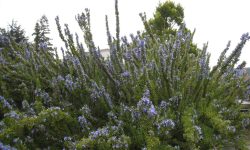How to Make Sage Tea at Home
What is Sage Tea? Choosing the Right Sage Leaves, Preparing the Sage Leaves, Brewing Sage Tea, Health Benefits of Sage Tea.
Welcome to our blog post all about sage tea! If you’ve ever wondered what sage tea is and how to make it, you’ve come to the right place. In this post, we will explore the different types of sage leaves that are ideal for tea-making, as well as the process of preparing and brewing sage tea. And let’s not forget about the numerous health benefits that sage tea offers. So, let’s dive into the world of sage tea and discover its wonders together!
What is Sage Tea?
Sage tea is a herbal infusion made from the leaves of the sage plant, scientifically known as Salvia officinalis. Sage is an evergreen shrub native to the Mediterranean region and has been used for culinary and medicinal purposes for centuries. The leaves of the sage plant are known for their distinct aroma and flavor and are commonly used as a seasoning in various dishes. However, sage leaves are also utilized to make a flavorful and aromatic tea, which can be enjoyed both for its taste and potential health benefits.
When it comes to sage tea, it is essential to choose the right sage leaves in order to ensure the best flavor and quality of the tea. Look for fresh and vibrant sage leaves that are free from any signs of discoloration or wilting. It is recommended to select organic sage leaves whenever possible to avoid the presence of pesticides or other harmful chemicals. Additionally, to enhance the flavor of the tea, you may consider opting for specific varieties of sage, such as Italian or Greek sage, which are known for their strong and robust flavor.
Preparing sage leaves for making tea is a relatively simple process. Start by gently rinsing the leaves under cold water to remove any dirt or debris. Pat them dry with a paper towel and then proceed to crush the leaves to release their essential oils and flavors. This can be done by rubbing the leaves between your fingers or using a mortar and pestle. Once the leaves are crushed, they are ready to be used for brewing sage tea.
Choosing the Right Sage Leaves
When it comes to making a delicious cup of sage tea, choosing the right sage leaves is essential. Not all sage leaves are created equal, and using the wrong kind can greatly affect the taste and quality of your tea. So, how do you know which sage leaves to pick? Let’s explore some factors to consider when selecting the perfect sage leaves for brewing your tea.
1. Freshness: Fresh sage leaves are crucial for achieving the best flavor in your tea. Look for leaves that are vibrant and green, without any yellow or brown spots. The fresher the leaves, the more aromatic and potent they will be, resulting in a more flavorful cup of tea.
2. Variety: There are several varieties of sage available, but the most common types used for making tea are common sage (Salvia officinalis) and pineapple sage (Salvia elegans). Common sage has a strong, slightly bitter flavor, while pineapple sage offers a sweeter, fruitier taste. Consider your personal preference and desired flavor profile when choosing between these varieties.
3. Organic and pesticide-free: To ensure the highest quality and avoid harmful chemicals, opt for organic and pesticide-free sage leaves whenever possible. Organic sage is grown without the use of synthetic pesticides or fertilizers, making it a healthier choice for both you and the environment.
- 4. Drying method: If you’re unable to find fresh sage leaves, dried sage can also be used for making tea. However, the drying method used can affect the flavor and aroma of the leaves. Air-dried sage leaves generally retain more of their natural oils and flavors compared to commercially dried leaves. If purchasing dried sage, look for leaves that have been air-dried for the best results.
| Factors to consider when choosing sage leaves for tea: |
|---|
| Freshness |
| Variety |
| Organic and pesticide-free |
| Drying method |
By taking these factors into consideration, you can ensure that you are selecting the right sage leaves for your tea. Whether you prefer the traditional flavor of common sage or the fruity notes of pineapple sage, choosing high-quality, fresh leaves will result in a delightful and aromatic cup of sage tea. So, the next time you’re at the store or farmer’s market, be sure to carefully select the perfect sage leaves for your tea-making endeavors!
Preparing the Sage Leaves
When it comes to making sage tea, the first and most crucial step is to properly prepare the sage leaves. Whether you have fresh sage leaves from your garden or dried leaves purchased from a store, ensuring the leaves are clean and ready for brewing is essential for a flavorful and aromatic cup of tea.
If you have fresh sage leaves, start by gently rinsing them under cool running water to remove any dirt or debris. Pat them dry with a clean towel or paper towel. Make sure to only use the tender and vibrant leaves, discarding any wilted or damaged ones.
If you are using dried sage leaves, there is no need to wash them. However, it is still important to examine the leaves for any signs of mold or spoilage. Dried sage leaves should have a rich green color and a strong aroma, indicating their freshness.
Once you have prepared the sage leaves, you have two options: crushing or leaving them whole. Crushing the leaves releases their natural oils and enhances the flavor of the tea. To crush the leaves, simply place them in a mortar and gently grind them with a pestle until they become slightly coarse. Alternatively, you can leave the leaves whole for a milder taste.
Now that you have properly prepared the sage leaves, you are ready to embark on your journey of brewing a soothing cup of sage tea. Remember, the quality of the sage leaves and their preparation play a significant role in the taste and aroma of the final tea. So take your time, enjoy the process, and savor the delightful benefits of this herbal infusion!
Brewing Sage Tea
Sage tea is a delightful and aromatic herbal infusion that has been consumed for centuries due to its numerous health benefits. Brewing sage tea is an easy and straightforward process that can be enjoyed at any time of the day. Whether you are a tea enthusiast or just looking to expand your palate with new flavors, sage tea is definitely worth a try. In this blog post, we will explore the step-by-step process of brewing sage tea to help you enjoy a perfect cup each time.
Before we dive into the brewing process, let’s briefly discuss some key points to consider when making sage tea. Firstly, it is important to choose high-quality sage leaves for the best flavor and aroma. Secondly, using fresh or dried sage leaves is a matter of personal preference, as they both result in a delicious cup of tea. Lastly, you can enhance the flavor of sage tea by adding honey, lemon, or other desired herbs and spices.
- Step 1: Gather the Ingredients
- Fresh or dried sage leaves (1 tablespoon per cup of water)
- Water
- Optional: honey, lemon, or other herbs and spices
- Step 2: Prepare the Water
- Step 3: Add the Sage Leaves
- Step 4: Steep the Tea
- Step 5: Strain and Serve
To brew sage tea, you will need the following ingredients:
Fill a kettle or pot with fresh, cold water. For the best flavor, it is recommended to use filtered water. Bring the water to a boil over medium-high heat.
Once the water reaches its boiling point, add the desired amount of sage leaves to the pot. If you are using fresh sage leaves, gently crush them to release their aromatic oils. For dried sage leaves, simply place them into the pot.
Turn off the heat and cover the pot with a lid. Allow the sage leaves to steep in the hot water for about 5-10 minutes. Steeping time may vary depending on your personal preference for the strength of the tea.
Using a fine-mesh strainer or tea infuser, strain the brewed sage tea into your teacup or mug. If desired, you can sweeten the tea with honey or add a squeeze of lemon for a refreshing twist. Serve the freshly brewed sage tea hot and enjoy!
Brewing sage tea is an enjoyable process that allows you to experience the full flavor and benefits of this herbal infusion. Whether you are sipping it for relaxation or to boost your overall well-being, sage tea is a wonderful addition to your tea collection. So why not give it a try and indulge in the soothing aroma and delightful taste of sage tea?
Health Benefits of Sage Tea
Sage tea is a popular herbal drink known for its numerous health benefits. This aromatic tea is made from the leaves of the sage plant, which is native to the Mediterranean region. Sage has been used for centuries in traditional medicine for its healing properties. In recent years, research has supported many of the health claims associated with sage tea.
One of the key health benefits of sage tea is its ability to improve digestion. The natural compounds found in sage leaves help stimulate the digestive system, promoting better absorption of nutrients and reducing digestive discomfort. Drinking sage tea after a meal can aid in digestion and prevent bloating or indigestion.
Sage tea is also known for its anti-inflammatory properties. The antioxidants present in sage leaves help reduce inflammation in the body, which can be beneficial for those suffering from conditions such as arthritis or inflammatory bowel disease. Regular consumption of sage tea may help alleviate symptoms of these inflammatory conditions.
Furthermore, sage tea has been found to have antimicrobial properties. The essential oils in sage leaves possess antibacterial and antifungal effects, making sage tea a natural remedy for various infections. Regular consumption of sage tea can help boost the immune system and fight off harmful bacteria and fungi in the body.
- Sage tea improves digestion
- Sage tea reduces inflammation
- Sage tea has antimicrobial properties
| Health Benefits | Description |
|---|---|
| Improves Digestion | Sage tea stimulates the digestive system, aiding in better nutrient absorption and reducing digestive discomfort. |
| Reduces Inflammation | Antioxidants in sage tea help reduce inflammation in the body, providing relief for conditions like arthritis. |
| Antimicrobial Properties | The essential oils in sage leaves have antibacterial and antifungal effects, helping to fight off infections. |
Frequently Asked Questions
What is Sage Tea?
Sage tea is a herbal infusion made from the leaves of the sage plant, scientifically known as Salvia officinalis. It is known for its distinct aroma and earthy flavor, and it has been used for centuries for its medicinal properties.
How do I choose the right sage leaves for tea?
When choosing sage leaves for tea, make sure they are fresh and vibrant in color. Avoid leaves that are wilted, discolored, or have signs of insect damage. It is best to pick young leaves for a milder flavor, while mature leaves will have a stronger taste.
How do I prepare sage leaves for tea?
To prepare sage leaves for tea, start by washing them thoroughly under running water to remove any dirt or debris. Then, pat them dry with a clean towel. Once dry, you can either use the leaves whole or crush them slightly to release their natural oils.
What is the process of brewing sage tea?
To brew sage tea, boil water in a kettle or pot. Once the water reaches a rolling boil, remove it from heat and add the sage leaves to the pot. Use approximately 1 tablespoon of sage leaves per cup of water. Let the leaves steep for 5-10 minutes, depending on your desired strength. Finally, strain the tea and serve hot.
What are the health benefits of sage tea?
Sage tea has several health benefits. It is known for its antioxidants and anti-inflammatory properties, which may help protect against chronic diseases. It is also believed to improve digestion, boost brain function, and promote healthy skin. However, it is always advisable to consult with a healthcare professional before using sage tea for medicinal purposes.
How can I store sage leaves for tea?
To store sage leaves for tea, you can dry them and keep them in an airtight container in a cool, dark place. Alternatively, you can freeze fresh sage leaves for later use. Proper storage will help retain the flavor and aroma of the sage leaves.
Can sage tea be consumed by everyone?
While sage tea is generally safe for most people to consume, it is not recommended for pregnant or breastfeeding women. It may also interact with certain medications, so it is advisable to consult with a healthcare professional if you have any underlying medical conditions or are taking medications.



